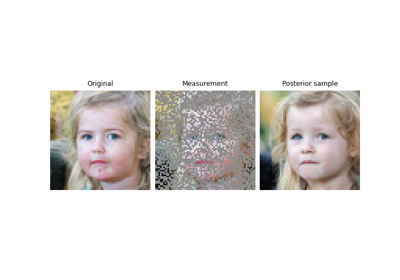save_videos#
- deepinv.utils.save_videos(vid_list, titles=None, time_dim=2, rescale_mode='min_max', figsize=None, save_fn=None, **plot_kwargs)[source]#
Saves an animation of a list of image sequences.
Plots videos as sequence of side-by-side frames, and saves animation (e.g. GIF) or displays as interactive HTML in notebook. This is useful for e.g. time-varying inverse problems. Individual frames are plotted with
deepinv.utils.plot()vid_list can either be a video or a list of them. A video is defined as images of shape(B,C,H,W)augmented with a time dimension specified bytime_dim, e.g. of shape(B,C,T,H,W)andtime_dim=2. All videos must be same time-length.Per frame of the videos, this function calls
deepinv.utils.plot(), see its params to see how the frames are plotted.
- Examples:
Display list of image sequences live in a notebook:
>>> from deepinv.utils import save_videos >>> x = torch.rand((1, 3, 5, 8, 8)) # B,C,T,H,W image sequence >>> y = torch.rand((1, 3, 5, 16, 16)) >>> save_videos([x, y], save_fn="vid.gif") # Save video as GIF
- Parameters:
vid_list (Union[torch.Tensor, list[torch.Tensor]]) – video or list of videos as defined above
titles (Union[str, list[str]]) – titles of images in frame, defaults to
Nonetime_dim (int) – time dimension of the videos. All videos should have same length in this dimension, or length 1. After indexing this dimension, the resulting images should be of shape
(B,C,H,W). Defaults to 2rescale_mode (str) – rescaling mode for
deepinv.utils.plot(), defaults to “min_max”figsize (tuple[int], None) – size of the figure. If
None, calculated from size of img list.save_fn (str) – if not
None, save the animation to this filename. File extension must be provided, noteanim_writermight have to be specified. Defaults toNone**plot_kwargs – kwargs to pass to
deepinv.utils.plot()
Examples using save_videos:#

Building your diffusion posterior sampling method using SDEs

